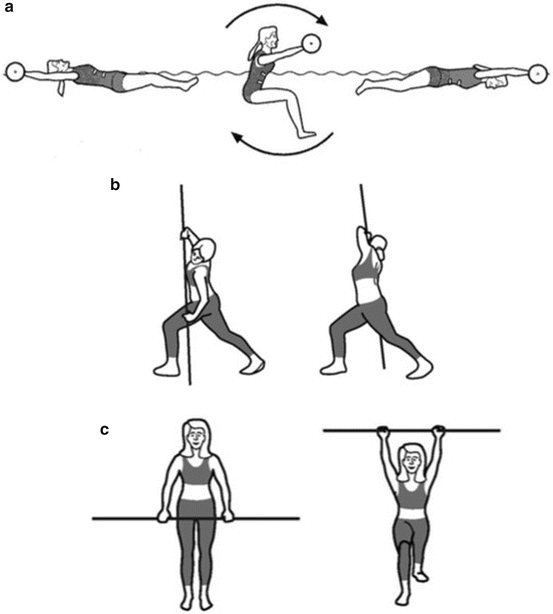Increased centralization of blood volume
Decreased heart rate
Increased work of breathing
Increased cardiac output
Increased sodium and potassium excretion
Increased intramuscular blood flow
Increased plasma levels of dopamine
Decreased joint pressure
Increased lymphatic return
Relaxation
Increased range of motion
Decreased pain
Changes in muscle tone
Provides traction
Understanding the physiological effects of water will allow the practitioner to guide the rehabilitation process with a better understanding of the potential outcome of the patient undergoing treatment, as well as a better understanding of how the potential outcome will differ from those obtained by traditional land-based therapies. There are some limitations and precautions unique to each case, which should be considered when creating a treatment plan. The most obvious of these is the patient’s acceptance of being immersed in water. Not everybody has had the ability to grow up with access to safe and clean recreational water activities and may have misgivings about entering into a water and land based rehabilitation program. In these cases, gradual explanation and progression of the program should be undertaken in order to ensure a solid level of trust between the patient and the practitioner. Using proper buoyancy devices and appropriate guidance makes water therapy accessible to everyone, regardless of their ability to swim.
The third power of water is its ability to offer resistance . The density of water allows individual grading of resistance levels and progression of muscles as hard or as gentle as needed in order to complete the rehabilitation process. Hidden in the ability to resist is the turbulence and turbidity of water on limbs as a patient moves through water. The tactile compression of water surrounding limbs and the turbulence of the water as it flows around the immersed patient create a gentle massage effect that can reduce pain, which is similar to how a water jet from a hot tub massages the muscles and reduces their tension at rest. The most obvious difference is that people move their own limbs and relearn how to use their bodies and how to create balance of the Six Essential Qualities of human performance (Fig. 27.1).


Fig. 27.1
Six essential qualities
These qualities are the cornerstone of The Burdenko Method and are displayed in a basic pyramid hierarchy [1]. Within each quality, there are specific exercises that allow the practitioner to address the needs of the patient, while developing the particular quality to that level. After each level description, there are examples of both pool and land exercises to help illustrate how The Burdenko Method is utilized in practice.
The first quality, which is at the base of this pyramid, is balance (Fig. 27.2 ). Without balance, nothing can last. This is not just the balance of the human body to remain upright, such as in a standing posture, but also in the balance of the entire body and all of its systems. When the body functions, it needs to have the right amount of balance in order to maintain homeostasis, to tolerate everyday changes, and to endure the stressors of our activities. Balance helps the body to remain resilient to disease and to injury. Laying the foundation of balance in the pool sets the basic parameters and helps the patient to understand the physical requirements that all other exercises in The Burdenko Method will require.


Fig. 27.2
Balance
The second quality is coordination (Fig. 27.3a, b). The controlled contraction and relaxation of muscles in the human body help to create movement. The more control over movement that can be obtained, the better quality of movement that will ensue. Some aspects of coordination are complex, whereas others are simpler. All successful motion must use a coordinated pattern of movements.Discoordination of movement often creates stiffness and injury. In The Burdenko Method, specific exercises are taught, which use the principle of progressing from simple to complex instruction. This helps to ensure that the patient is able to understand and to digest how each body part functions individually, as part of a group, and then eventually as part of a whole. Repeating these patterns creates plasticity in the brain by challenging it just to aid in regaining control over painful body parts.


Fig. 27.3
(a, b) Coordination
The third quality is flexibility (Fig. 27.4a–c). Each muscle needs to have the right amount of flexibility in order to function. In traditional rehabilitation, flexibility is often the first quality that is addressed, even though it is often not the best first step. Achieving good, lasting flexibility is best done through active movements, which cannot take place without a good foundation of coordination and balance.


Fig. 27.4
(a–c) Flexibility
The quality of endurance ability to produce for an extended time or to last performs best when all the qualities before it are built solid. We often see biomechanical breakdowns and injuries when fatigue settles into the systems, as a result of too much energy spent trying to maintain balance, or from being forced to perform coordinated movements poorly. Additionally, it can also be the result of muscles being asked to pull through large ranges of motion and/or by being forced to spend energy trying to stabilize their ends under load.
Speed and quickness (Fig. 27.5a, b) are often used interchangeably and involve the ability of the body and its parts to change direction and velocity. Mastering these qualities allows the patient to perform all tasks at a greater confidence level and with better resiliency. It also allows the patient to challenge his/her physiology and to properly stress his/her cardiovascular systems to yield the maximum benefit.







